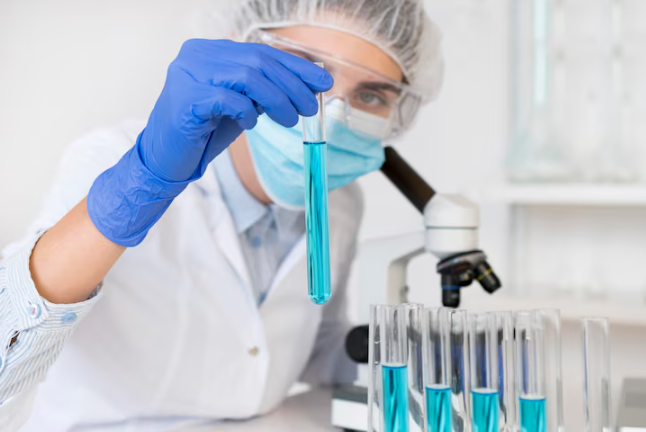Antibodies are essential tools in diagnostics, therapeutics, and research, serving as critical agents in identifying, neutralizing, and quantifying biological targets. The process of isolating high-quality antibodies from complex biological mixtures such as serum, ascites fluid, or culture media has traditionally relied on methods like affinity chromatography or precipitation. However, these conventional approaches often involve labor-intensive procedures, high costs, and limited flexibility for scale-up or automation.
To address these limitations, Protein A/G magnetic beads have emerged as a revolutionary platform for efficient, scalable, and reproducible antibody isolation. By combining the strong binding affinity of Protein A/G with the simplicity and speed of magnetic separation, this technology offers a streamlined and cost-effective alternative for isolating antibodies with high purity and yield.
What Are Protein A/G Magnetic Beads?
Protein A and Protein G are bacterial proteins that bind specifically to the Fc region of immunoglobulin G (IgG). Protein A, derived from Staphylococcus aureus, exhibits strong binding to IgG from humans and several animal species. Protein G, from Streptococcus species, has a broader binding profile, particularly for rodent IgGs. A recombinant fusion of both proteins—Protein A/G—provides enhanced binding capabilities across a wide range of IgG subclasses and species.
When Protein A/G is immobilized on magnetic beads, the result is a highly versatile tool for isolating antibodies with superior specificity and minimal non-specific binding. These beads are suspended in an aqueous buffer and can be manipulated easily using a magnetic field, enabling quick separation and reducing the need for centrifugation or filtration.
Key Benefits of Protein A/G Magnetic Beads for Antibody Isolation
High Binding Affinity and Specificity
Protein A/G magnetic beads bind selectively to the Fc portion of IgG, allowing for efficient isolation of target antibodies from complex biological samples. This specificity ensures high purity with minimal contamination.
Broad Species Reactivity
The Protein A/G fusion binds effectively to IgGs from humans, mice, rats, rabbits, goats, and other mammals. This cross-species compatibility makes it ideal for multispecies experiments and hybridoma screening.
Fast and Efficient Workflow
Magnetic bead-based isolation drastically reduces processing time. The typical protocol—including binding, washing, and elution—can be completed in less than two hours, a significant improvement over traditional chromatography.
Scalability
Whether you’re working at a small laboratory scale or conducting high-throughput purification, Protein A/G magnetic beads can easily scale to match your requirements. They are compatible with manual or automated systems, making them suitable for research, clinical, and industrial applications.
Preserves Antibody Function
The gentle binding and elution conditions help maintain the structural integrity and biological activity of isolated antibodies, ensuring they are suitable for downstream applications like ELISA, Western blotting, flow cytometry, and therapeutic use.
Step-by-Step Guide to Isolating Antibodies Using Protein A/G Magnetic Beads
Sample Preparation
Start with a clarified antibody-containing sample such as culture supernatant, serum, or ascitic fluid. If the sample contains particulate matter, pre-filter it to avoid fouling the beads.
Bead Washing
Thoroughly mix the magnetic beads by gentle pipetting or vortexing. Wash them 2–3 times with a binding buffer (e.g., PBS or TBS) to remove storage preservatives and ensure optimal performance.
Antibody Binding
Combine the washed beads with your sample in a microcentrifuge or conical tube. Incubate at room temperature or 4°C for 30–60 minutes with gentle mixing to allow antibody binding.
Magnetic Separation
Place the tube in a magnetic rack. Once the beads have migrated to the side, carefully aspirate the supernatant. Avoid disturbing the bead pellet.
Washing
Wash the beads multiple times with the binding buffer to eliminate non-specifically bound proteins and impurities. Each wash should include a brief resuspension followed by magnetic separation.
Elution
Elute the bound antibodies using a low-pH elution buffer such as 0.1 M glycine-HCl (pH 2.8). Immediately neutralize the eluate with a neutralization buffer (e.g., 1 M Tris-HCl, pH 9.0) to preserve antibody integrity.
Optional Bead Regeneration
If the beads are reusable, clean them with a regeneration buffer and store in a suitable buffer containing a preservative for future use.
Applications of Isolated Antibodies
The high purity and functionality of antibodies isolated using Protein A/G magnetic beads make them suitable for a wide range of applications:
- Diagnostics: Use in ELISAs, lateral flow assays, and other immunoassays for disease detection and monitoring.
- Therapeutics: Purify therapeutic antibodies with consistent quality for preclinical and clinical studies.
- Proteomics: Employ in immunoprecipitation (IP) and co-immunoprecipitation (Co-IP) for studying protein interactions.
- Research: Use in flow cytometry, immunofluorescence, and Western blotting for detecting target proteins.
Tips to Maximize Efficiency and Yield
- Optimize Binding Conditions: Use the recommended buffer and bead-to-sample ratio for your specific IgG subclass and species.
- Avoid Bead Clumping: Ensure beads are fully resuspended before use to prevent clumping and uneven antibody binding.
- Minimize Sample Loss: Handle beads gently and avoid multiple transfers to reduce sample loss.
- Protect from Degradation: Include protease inhibitors during incubation and work at cold temperatures when necessary.
Common Issues and Troubleshooting
- Low Recovery: Check bead capacity, increase incubation time, or ensure adequate mixing.
- Non-Specific Binding: Add a blocking agent like BSA or optimize the washing conditions.
- Poor Elution: Confirm pH and ionic strength of the elution buffer; perform multiple elutions if needed.
Why Protein A/G Magnetic Beads Are the Smart Choice
In an era of increasing demand for precision, speed, and reproducibility in biological workflows, Protein A/G magnetic beads stand out as an intelligent upgrade to traditional antibody purification techniques. They reduce complexity, increase throughput, and deliver high-purity antibodies with ease.
Whether you’re working in academic research, biotech, or a clinical environment, adopting magnetic bead technology can dramatically enhance your workflow. The ability to quickly isolate functional antibodies from a variety of sources, without compromising quality or yield, opens up new possibilities in antibody-based discovery and development.
If you’re ready to simplify your antibody isolation process and improve the quality of your results, click this link now to explore top-rated Protein A/G magnetic bead products that meet your lab’s needs.
Experience the benefits of modern antibody purification—faster, cleaner, and more efficient than ever before.
